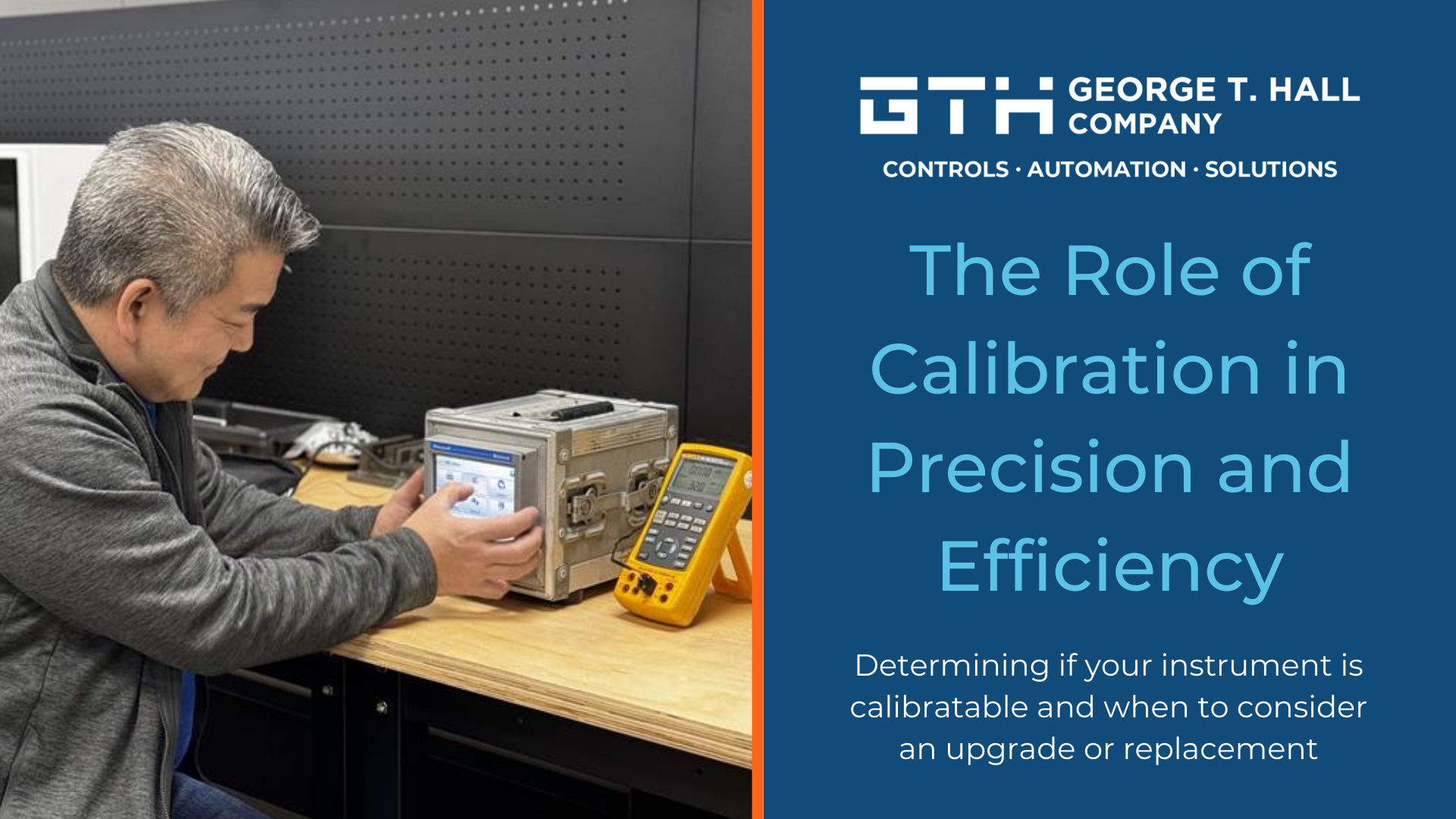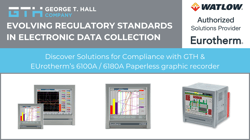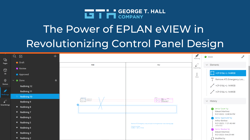Blog

The Role of Calibration in Precision and Efficiency
Determining if your instrument is calibratable and when to consider an upgrade or replacement
Maintaining accuracy within our nation’s critical infrastructure sectors such as water/wastewater plants, pharmaceutical laboratories, and mining operations, to name a few, is a strategic imperative. Regular calibration of instruments plays a pivotal role in ensuring their accuracy, reliability, and longevity. This article explores the importance of regular calibrations, methods to identify when instruments need replacement and how George T. Hall Company (GTH) stands ready to support ongoing calibrations and provide recommendations for functional replacement(s).
Regular calibration ensures that instruments provide accurate measurements, a critical factor in industries where precision is paramount. Adhering to industry standards is non-negotiable. Calibrated instruments are more reliable, fostering trust in consistency of readings and reducing the likelihood of errors in the decision-making process. Identifying and addressing potential issues through regular calibration contributes to the longevity of instruments, resulting in increased efficiency by preventing premature replacements. Calibrated instruments operate at their optimal performance levels, enhancing productivity and safety in various processes.
Selecting a company for instrument calibration is a critical decision. Opting for a System Integrator, such as GTH, that boasts Control System Engineers on our team ensures a strategic approach to maintaining the optimum accuracy of your instrumentation. With our Control System Engineers and Technicians, you benefit from their extensive knowledge of components and a collective experience spanning over a century. We offer reliable calibration services designed to meet your process and quality requirements. Our Field Engineers use NIST-traceable instruments to perform gas, temperature, pressure, and level calibrations on a variety of instruments including Chart / Video Recorders, Controllers, Gas Analyzers, and Temperature Sensors. We comply with industry best practices and utilize ISA data sheets when required.
With a diverse array of instruments requiring calibration across various industries and applications, our focus in this blog centers on the essential calibrations for chart / video recorders and the potential upgrades or replacements available. Let us start by examining the essential maintenance tasks for paper recorders and whether calibration is necessary for these instruments.
Paper recorders, also known as chart recorders or strip chart recorders, typically do not undergo calibration in the same manner as electronic instruments. The calibration process, involving the adjustment or verification of a measuring instrument's accuracy, is more pertinent to electronic or digital devices. Paper recorders utilize physical pens or markers to create a trace on paper, relying on mechanical components. Ensuring the mechanical integrity of the recorder and the good condition of pens or markers is crucial.
While regular maintenance practices, such as checking and replacing pens, ensuring proper paper alignment, and inspecting mechanical parts, are more common for paper recorders than calibration, it is important to note that specific types of paper recorders may have unique maintenance requirements. Therefore, consulting the manufacturer's instructions or documentation is advisable for guidance on maintaining and ensuring the accuracy of any paper recorder.
In our previous blog, titled, “Navigating the Digital Frontier of Industrial Operations: the Path to Paperless Record-Keeping”, we discussed the transformative shift from traditional paper-based record-keeping to a digital system. This transition offers benefits such as increased efficiency, cost-effectiveness, and a positive environmental impact. In this blog we will dive deeper into the specific calibration requirements, guiding you on when it is time to consider an upgrade or explore functional replacements for your instruments.
As technology evolves, it becomes imperative for industrial operations to stay abreast of advancements, meeting not only regulatory standards but also minimizing environmental impact. The inevitable progression for all operations involves upgrading to digital recorders for streamlined data collection. Strategic and regular calibration, as highlighted at the beginning of this article, is instrumental in ensuring that instruments adhere to regulatory standards, providing reliable data and preventing premature replacements.
Calibration, is the process of adjusting or verifying the accuracy of a measuring instrument against a known standard, is pivotal. At GTH, we perform various common calibrations for our industrial customers on their digital recorders. These include sensor calibration, electronic calibration, input calibration, time calibration, environmental calibration, as well as calibration for HMI’s and communication interfaces.
Digital recorders commonly employ sensors to measure physical parameters like temperature, pressure, or flow. Sensor calibration is the process of comparing the sensor's output to a known reference to correct any deviations, ensuring the recorder provides precise and repeatable measurements. In addition to sensors, digital recorders often integrate electronic components, including analog-to-digital converters (ADCs) or signal conditioning circuits. Electronic calibration becomes essential to adjust these components, aligning them with reference standards to minimize errors introduced during the conversion process.
In cases where a digital recorder features multiple input channels, it is crucial to calibrate each channel individually. This ensures uniform accuracy across all channels by adjusting and verifying their response to match a known standard. Some digital recorders may also incorporate a timekeeping function, where calibration guarantees accurate timestamping of recorded data—particularly critical in applications where event timing holds significance.
Digital recorders, designed for diverse environmental conditions, may undergo calibration to assess their performance under varying temperatures, humidity levels, or atmospheric pressures. This calibration ensures accurate measurements irrespective of the operating environment. Furthermore, if a digital recorder includes a display or user interface, calibration is necessary to verify that displayed values accurately correspond to the recorded data, allowing users to interpret information correctly.
For digital recorders with communication interfaces, such as USB or Ethernet, calibration is vital to ensure the accurate transfer of data between the recorder and external devices or systems. Over time, electronic components may experience performance drift, making periodic recalibration necessary. The frequency of recalibration depends on factors like usage, regulatory requirements, environmental conditions, and manufacturer recommendations.
The decision to transition from a digital recorder to software-driven data collection, exemplified by platforms like Ignition® from Inductive Automation, hinges on various critical factors. These factors encompass scalability needs, integration requirements, real-time monitoring, customization and flexibility, remote access and mobility, historical data analysis, and end-of-life technology. Exploring these indicators illuminates when it becomes essential to consider upgrading to software-driven data collection.
If your data collection requirements have expanded, necessitating the monitoring, and recording of a growing number of data points, a software-driven solution becomes indispensable for scalability. Ignition, for example, is renowned for its scalability, adept at handling substantial data volumes from diverse sources. For seamless integration with other systems, databases, or enterprise software, opting for a software-driven solution like Ignition® is advantageous. Specifically designed for industrial automation and SCADA applications, Ignition offers enhanced integration capabilities, fostering a more connected and interoperable data collection system.
When real-time monitoring and data analysis become pivotal for operational success, a software-driven solution stands out. Ignition®, for instance, supports real-time data streaming and advanced visualization features, providing the tools needed for comprehensive real-time insights. Should your data collection and reporting requirements be unique or entail specific customization needs, a software-driven solution's flexibility becomes invaluable. Ignition® allows extensive customization, empowering you to tailor the system to your exact specifications.
For those requiring remote access to data or monitoring and controlling processes from various locations, a software-driven system such as Ignition®, often equipped with web-based interfaces, ensures enhanced mobility and accessibility. If historical data analysis holds significance for informed decision-making or regulatory compliance, a software-driven solution typically excels. Ignition® offers advanced historical data storage, retrieval, and analysis tools to meet these needs effectively.
While the initial cost of implementing a software-driven solution may be higher, the long-term cost savings in maintenance, upgrades, and scalability are noteworthy. It is crucial to consider the overall cost-effectiveness and potential return on investment when assessing the need for any upgrade. If your current digital recorder is approaching the end of its life cycle or becoming obsolete, it naturally prompts exploration of modern solutions. Upgrading to a software-driven system ensures that you leverage the latest technology with the added benefits of ongoing support and timely security updates.
Ready to enhance the accuracy, reliability, efficiency, and security of your industrial operations? Contact George T. Hall Company (GTH) today for a thorough assessment of your current data collection needs and discover how our expertise in instrument calibration and software-driven solutions, such as Ignition® from Inductive Automation, can elevate your processes. Whether you are considering essential calibrations, exploring upgrades, or in need of a comprehensive transition to software-driven data collection, we are here to provide customized solutions for your unique requirements. Take the next step towards precision and innovation – contact us for a consultation.
RELATED POSTS
In the rapidly evolving world of controls and automation, efficient design and manufacturing processes...
Manual Grind Line Modernization




